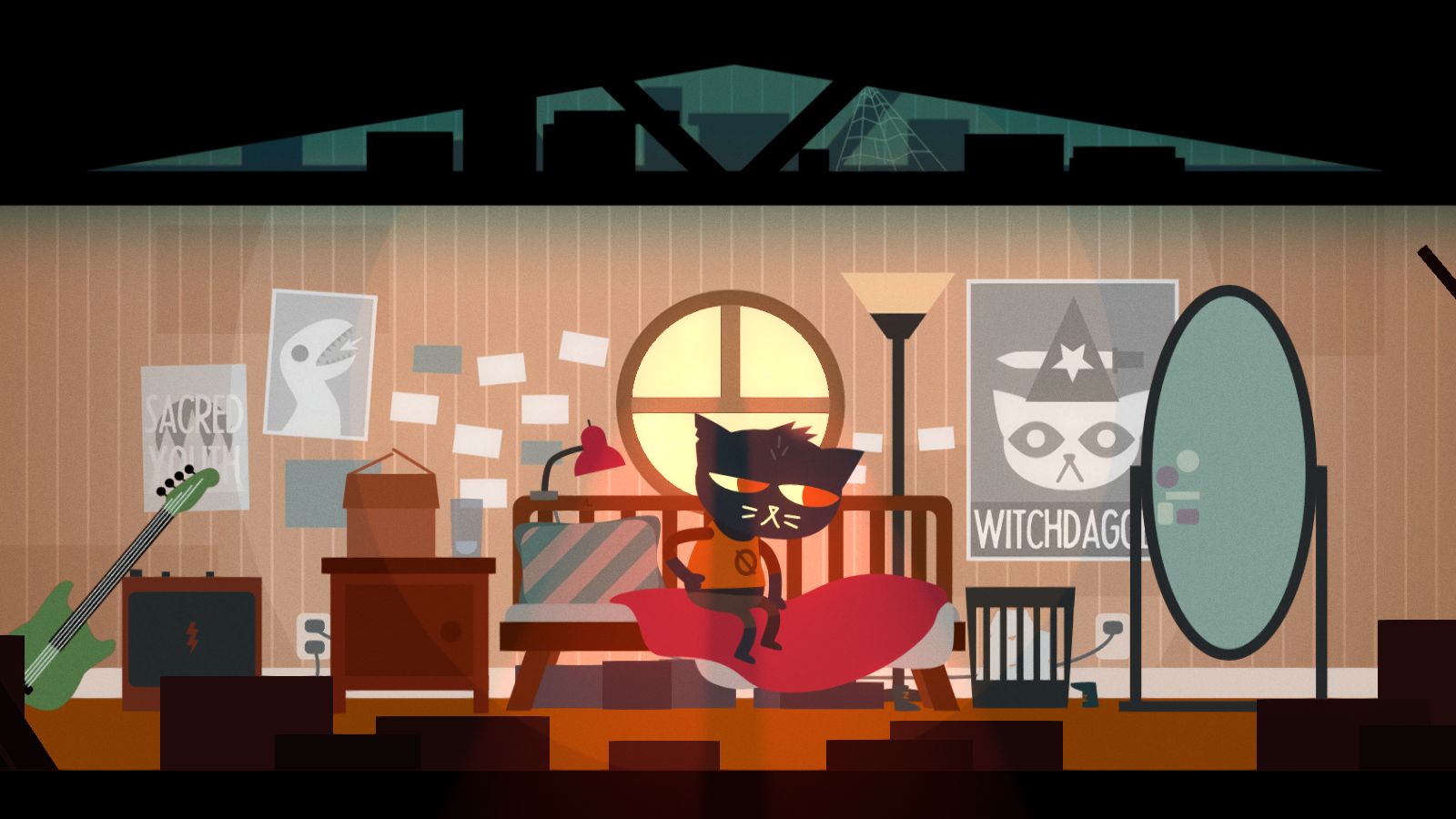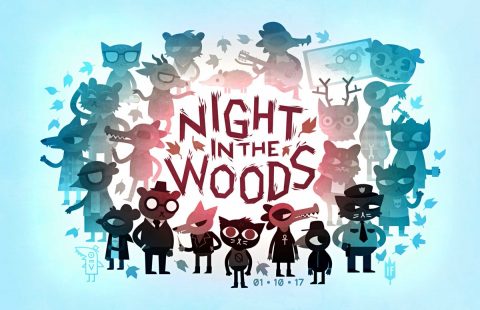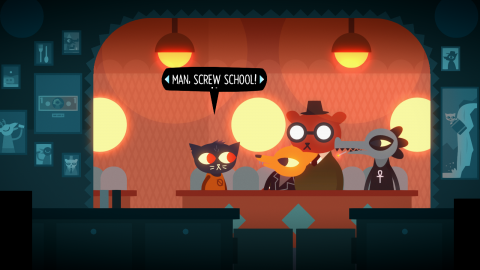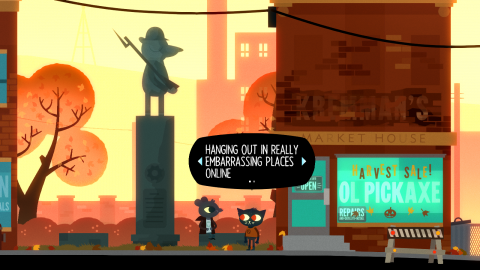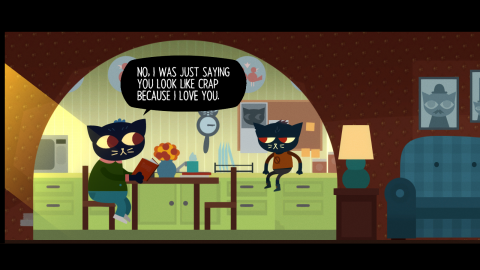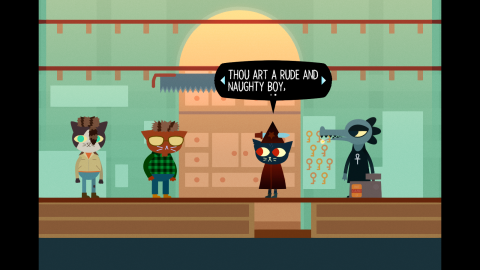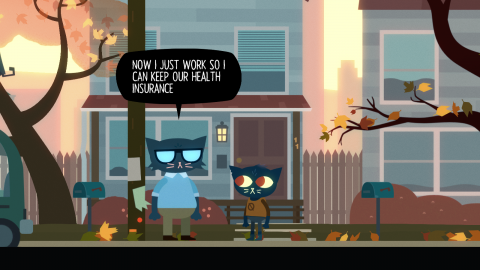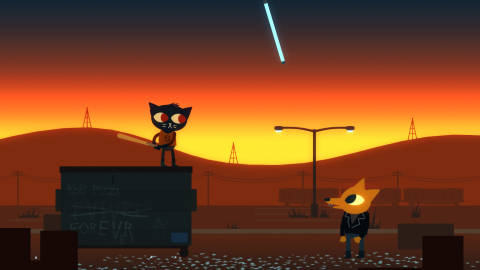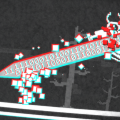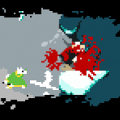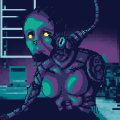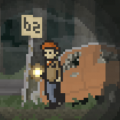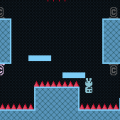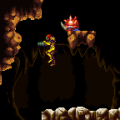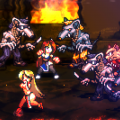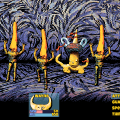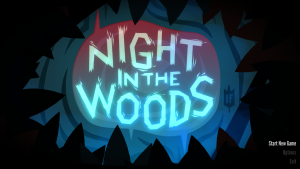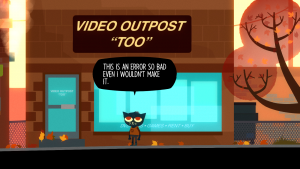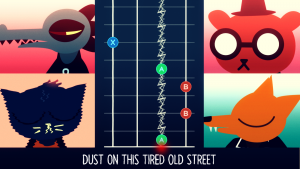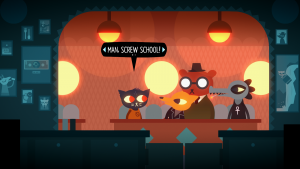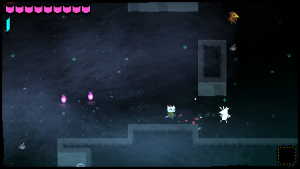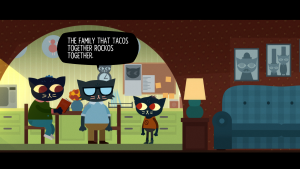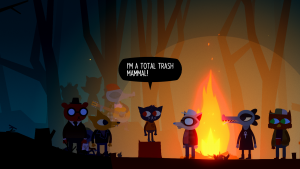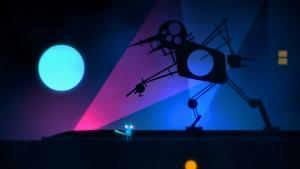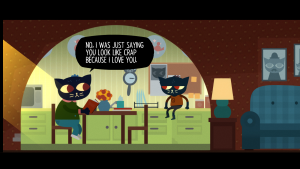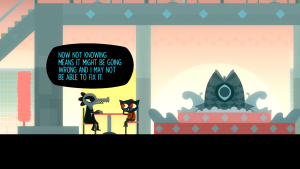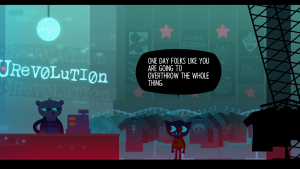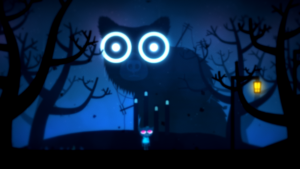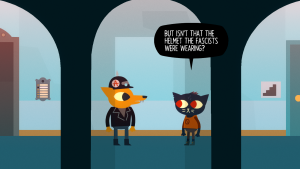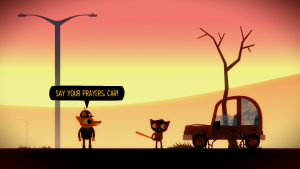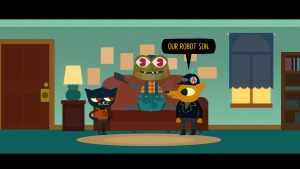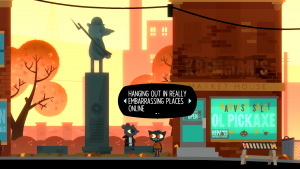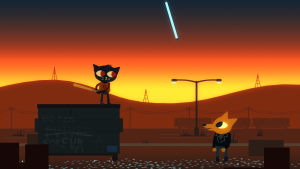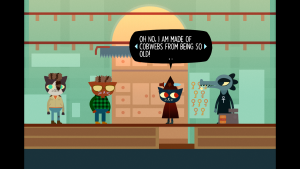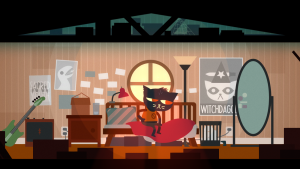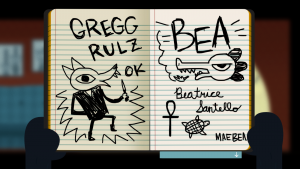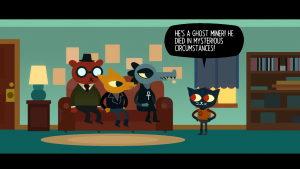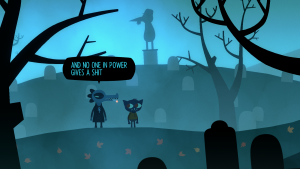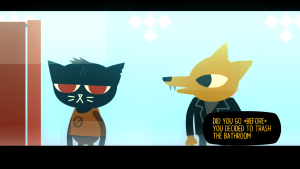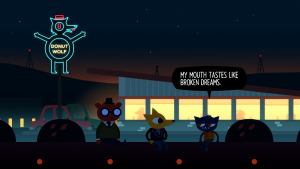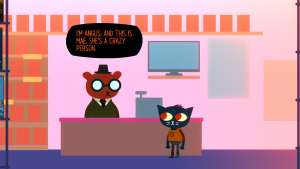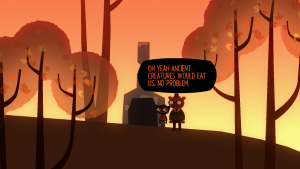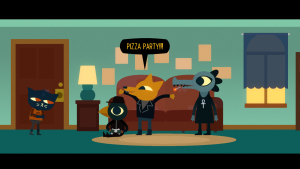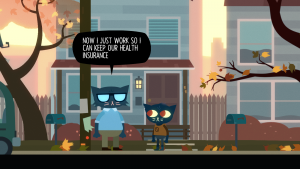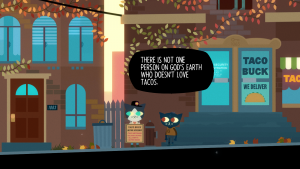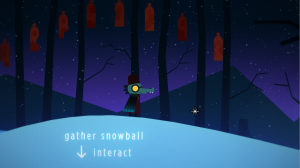Night in the Woods, an extraordinary narrative experience by Scott Benson, Bethany Hockenberry, and Alec Holowka, tells a different type of story than most video games. On the surface, it presents itself as a horror story, but it’s much more than that – it’s about dreams, about growing up and moving out, about capitalism and its victims, and about mental illness and the tolls it takes. It’s weighty stuff for a game starring an anthropomorphic cat, in a filled with other human-like animals.
The story focused on Mae Borowski, the first in her family to go off to college. She manages to make it about a year and a half before dropping out, returning back to her parents’ house in her hometown of Possum Springs, without offering much of an explanation. She resumes the life that she knew before high school, hanging out with friends and generally just goofing off. While she tries to capture the feelings that she felt she lost, she’s disturbed by a series of nightmares, suggesting some kind of demon that dwells beneath the town. To accompany these disturbing nightmares, she happens upon a dismembered limb on the street one day, and witnesses one of the serial kidnappings that seem to be occurring around town. It’s through careful research into her town’s history, and the help of her friends, that she begins to untangle the mystery.
The game is set up like a side-scrolling platformer, as Mae wanders around towns and talks to people. However, there’s barely anything in the way of puzzles or challenges, and even when there are, they feel weirdly out of place. It’s heavily dialogue based, though it doesn’t really use dialogue trees like most adventure games – you just choose between responses (typically one of two) and then the conversation goes on. In many ways, it’s sort of like a visual novel, just with more direct control and interactivity. It might seem like that doesn’t mean much on the surface, but it really gives the town more character, as you can jump on people’s cars, teeter on the electric lines, and otherwise interact with the environment in ways that are more satisfying than just point and clicking.
There are a few exceptions, most notable the dream sequences, where you control Mae through dark landscapes, following glowing lights until you’ve lit all four points in each area. These aren’t particularly long, and while they do grow repetitive, they’re bolstered by the music. Each of these levels starts off in near silence, but each way point you find uncovers a band member, which adds another instrument, eventually creating a fully textured theme.
There are a few mini-games too, like where you need to shoplift something without a clerk noticing, or knock out fluorescent lights with a baseball bat. There are also a few rhythm game sections when you join your buds for band practice. There’s no way to actually “fail” these though, as it’ll just potentially change some of the doodles in Mae’s notebook. The music sections are deliberately difficult, if mostly because, as Mae complains, she doesn’t know the song and she hasn’t played the bass in forever, so the game expects you to be awful at it too.
You can also muck around on Mae’s computer, and use instant messenger to chat with her friends, but it also has its own mini-game called Demon Tower. It’s a rather simple but fun rogue-like, that makes for some fun diversions if you get tired of just walking around and talking. You never need to play it if you don’t want to, though.
Despite the intriguing story, and its relatively short length, Night in the Woods only casually wanders through its plot developments. There’s certainly weird stuff going on, but Mae isn’t really compelled to be a part of it, at least at first. Instead, the first half of the game is just spent hanging out with her old friends, who are still in town. Her best buddy Gregg is a fox, who works at the local convenience story but will abandon his post at a drop of a hat (seemingly without consequence) to hang out with Mae. Angus is his mildly geeky boyfriend, a large bear who works at a video store (which is somehow still in business). And Bea is an alligator who has taken over her family’s hardware store business after her mother passed away, whose grade school friendship with Mae has since dissolved. The town itself is just as much of a character too, as Possum Springs is an old mining town whose industry has since been closed, resulting in all of the old employees being stuck in retail jobs, and their children leaving for greener pastures, leaving nothing but economic turmoil.
Each day follows the same pattern – Mae wakes up, explores the town, chats with the locals, spends the evening with one of her friends, goes to sleep and has a nightmare, then wakes up again. In some cases, the events are the same each day, like for any the group gets together for band practice, but others are dependent on which friends you prioritize. There’s no way to view all of the different scenarios in a single playthrough (though can see everything in two, if you know what you’re doing), which gives you an incentive to play through the story again once you’ve completed it. There’s only one main plot thread, but some dialogue changes depending on what you’ve done previously.
Even though they don’t directly affect the narrative, these scenes are some of the best parts of the game. Gregg is happy as anything that Mae is back in town, and is eager to return to the days of goofing off and committing petty crimes. Meanwhile, Bea’s relationship with Mae is much more tense, having gone frigid for reasons that aren’t initially revealed, and needs to be rebuilt over the course of the story. Angus, on the other hand, is somewhat of an outsider, a friend of a friend, who slowly warms up to Mae’s oddness. It ensures that each of these different scenes has a different tones, especially comparing Gregg’s optimism and excitability with Bea’s more pessimistic worldview. Most strikingly, each of them is growing up in their own way, something Mae is running away from, but all cope in their own ways.
These trio is at the center of the game’s interactions, but the townspeople of Possum Springs are just as interesting. Despite their financial hardships and occasionally strained relationship with their daughter – they’re not entirely clear why they spent years saving up money for Mae to go to school, only for her to drop out because she feels like it – but they’re generally caring and funny folks. You wake up each morning to have a chat with her mom, then return at night to watch terrible late night TV with her dad. Each day you can talk to Selmers, slightly older than Mae but even more world weary, and listen to her goofy if heartfelt poems. There’s the old dude who tells Mae to get off his property in increasingly amusing ways, or your old science teacher, who watched dusk stars through his telescope. Some of them you’ll miss if you don’t explore around the town. Much like the mini-games, who you talk to, and what events you witness, will flesh out Mae’s notebook with more of her comical doodles.
The writing style has a very succinct, casual feel to it, one that mimics the way close friends talk to each other without resorting to the type of slang that made, say, Life is Strange feel little strained. There are plenty of great scenes, quotable lines of dialogue, and in-jokes that build up over the course of the game, one of the best being the terrifying Chuck E. Cheese-style “robot son” you can piece together from salvaged parts. A runner-up is the heavily improvised Halloween play that Mae gets coerced into starring in. The various stores and restaurants also have curiously amusing names, typically animal themed, like Snack Falcon, Donut Wolf, and Ham Panther.
Mae is an excellent protagonist, primarily because there are so few like her in the world of gaming. She’s charming and funny, often dry and a bit sarcastic. But she’s also self-centered and immature, and is struggling with the personal problems that compelled her to drop out of college. She has her problems, and the game doesn’t really expect you to relate to her propensity for petty crimes, especially as the game makes you participate in them. But she’s a flawed character that wants to grow, even if she doesn’t know how, and she’s surrounded by friends that want to help her. You don’t need to directly relate to Mae in order to find meaning in her plight, because there are some pretty universal themes and very adult fears – coming home after a significant period of time, meeting with old friends and seeing how they’ve changed or grown, witnessing the ravages of progress and saying good-bye to now-decrepit hang-outs.
Unlike many other games, it also wears its politics on its sleeve. Both the story and its characters aren’t afraid to espouse the downsides to unregulated capitalism, as it both built and ruined the town of Possum Springs. Its release was a curious coincidence, as it came out just two months after the election of Donald Trump. After all, Night in the Woods takes place in a dying rust belt town in Pennsylvania, the part of the United States that was one of the major aspects that tilted the election in his favor. The story acknowledges that many problems are real but greatly disagrees on how to deal with them. One of the major themes of this game is “What lengths will people go to return to a place that can never exist again?”, from both a personal perspective (growing up) and a broader perspective (a dying town). For the latter, the game makes it clear where Mae and friends stand on this issue.
The one part where the game stumbles in its finale. It deals with several different themes – mental illness, nostalgia, capitalism – but when it tries to unite and add in some supernatural themes, it doesn’t quite come together. Still, it doesn’t damage the fun time you spend with the characters or the overall message of the story.
Just as important to the storytelling is its visuals and sound. The art style uses lots of round shapes and simple colors, looking a bit like an animated storybook but it’s charming, and there are lots of little details in the animations that make the characters feel more alive. Mae’s gigantic eyes make her immediately endearing in spite of her some more troublesome personality issues, and even slight changes to her expression have an immediate effect. Gregg’s exuberantly waving arms contrasts to Angus’ simplistic, arms-by-his-side walking animation, and Bea has a perpetually lit cigarette in her mouth. The game has a nice autumn atmosphere too, one that presents that town as beautiful on the surface, with its economic turmoil only visible with the number of vacant storefronts.
The music, by Alec Holowka, is just as much of a part of the game’s personality as the art style. It’s very laid back, with many melodic pieces that lend a nostalgic feel. There’s also a lot of it – the soundtrack is spread over two releases, with over one hundred tracks between them. A lot of them are quick ditties, but nearly every location and character has its own theme, many of which are several minutes long. Even the songs where you’re exploring the town change several times over the course of the story.
There’s no voice acting, but for the kind of writing style, it’s better this way – a lot of it would sound weird when spoken. The only downside to this is with the band practice songs – they have lyrics, shown at the bottom of the screen, but without vocals, they feel a little empty, even if the main melodies are awesome. The fan community quickly took it upon themselves to make covers of the three tracks – “Die Anywhere Else”, “Weird Autumn” and “Pumpkin Head Guy” – with their own vocals added in, which makes up for this shortcoming.
There are a few minor technical issues to note – there’s no way to manually save, and only one save slot that’s automatically overwritten each time you enter a new scene. There are tons of great segments and it would’ve been great to be able to replay them without restarting the whole game. Similarly, even if you do replay it to see the different scenarios, there’s no way to fast forward through dialogue or fast forward through parts you’ve already seen.
In turn, the fact that these elements are missed highlights the strengths of Night in the Woods. It’s a game filled with warm and funny characters, tons of memorable characters, some great art and a brilliant soundtrack. Plus, it feels so much more relatable than nearly all other games out there, in spite of starring walking, talking animals. It’s the sort of game that will be loved for years to come, as both a great story and a sign of our times.
Preceding Night in the Woods’ release in 2017, there were two other free supplemental games that introduce the game’s characters. In Longest Night, you join the cast stargazing late at night around a campfire, tracing lines between the stars. When you reveal a form, you’ll trigger a story about the (fictional) constellation. A similar segment is in the main game where you look through Mr. Chazokov’s telescope to look for “dusk stars”. Lost Constellation takes the form of a story told by Mae’s grandfather, about a astronomer named Adina Astra, who travels through a haunted forest to the Frozen Lake in order to visit the ghost of her deceased lover. Neither are essential to the main story, but they add some nice background, especially in the brief glimpse of Mae and her grandfather, who had passed away by the start of the main game.
